
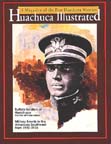 Equipment: 1910-1939
Equipment: 1910-1939The soldier would come to know well the personal equipment issued to him for use in the field, for each Saturday morning he would scrub it clean and lay it out on his bunk to be inspected by his squad leader, platoon sergeant, first sergeant and company commander. With the exception of the green recruit, each man knew precisely how the shelter half was folded so that one-half of its height equalled the length of a tent pin, and its full height matched the length of the tent pole; and how the comb, toothbrush, razor blades an razor were exactly centered on the flap of the haversack. It was an analog for their routine-precise and uniform. There was a clean sense of order in this regimentation; a place for everything and everything in its place. If the Army did not issue it to you, you probably did not need it. Even wives could be acquired only after the company commander approved of this extraneous baggage.
Display of basic individual equipment,
rifle platoon trooper.
(From War Department Field Manual)
-------
-------
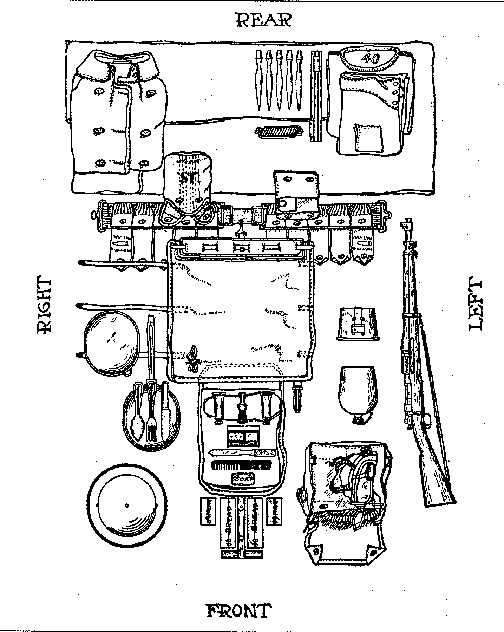
Equipment display for infantryman, 1918. (From War
Department Field Manual)
 ---------
---------
The garrison cartridge belt. ----------------------The
pack and cartridge belt, less overcoat and helmet.
(From War Department Field Manual)------------(From War Department Field Manual)
In 1910 the Army's Infantry Board developed its first gear for disbursing the weight of the soldier's equipment around the body. Made of khaki webbing and canvas duck by the Mills Company, this system would survive in its basic design style until the 1956 load-carrying equipment made its debut. Designed to carry 48 lbs. (50 lbs., or 1/3 the body's weight, was determined by studies to be the maximum to avoid exhaustion), the pack carrier with suspenders and cartridge (or garrison) belt were the basic components. To the pack carrier was attached the haversack and the long pack roll upon which was affixed the entrenching tool and the M1905 bayonet. In the haversack were carried rations, toilet articles, and the meat can or mess kit. The overcoat was rolled and strapped over the top of the haversack in a horseshoe shape. The blanket, poncho, and extra clothing were rolled up in the shelter half and tied vertically into the pack carrier. In its dismounted configuration, the cartridge belt carried a bolo, canteen cover, and first aid pouch. A garrison belt had a single cartridge pocket and a circular "US" fastening device at the front, with saber slings for officers and staff NCOs. Officers had an eagle coat of arms on the fastener. All of these equipments bore a M1910 model year.
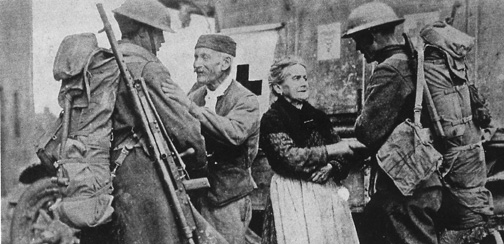
Two soldiers in France in 1918 wearing the pack with full equipment. (U.S.
Army photo)
 Just as the Infantry had developed its M1910 equipment, the Cavalry
Board did likewise with a M1914 series of personal equipment. Earlier the
board had approved horse equipment which bore the M1912 designation even
though it did not reach the field until 1913. Together referred to as the
M1912/14 series, it incorporated some of the M1910 infantry gear. A ration
bag folded into a knapsack. On the belt was carried the magazine pocket,
tool frog, rifle belt ring, M1910 canteen cover, and M1912 holster with
an M1911 pistol. The tool carrier could carry either a pick or a hatchet
head, and horse shoes and nails. The M1912 garrison belt for cavalrymen
was russet leather and had a cartridge pocket, rifle belt ring and rifle
strap, two sliding frogs for the M1910 first aid pouch and the M1912 holster
and the M1912 leather magazine pocket. A bandoleer for carrying additional
ammunition was also part of the 1914 equipments.
Just as the Infantry had developed its M1910 equipment, the Cavalry
Board did likewise with a M1914 series of personal equipment. Earlier the
board had approved horse equipment which bore the M1912 designation even
though it did not reach the field until 1913. Together referred to as the
M1912/14 series, it incorporated some of the M1910 infantry gear. A ration
bag folded into a knapsack. On the belt was carried the magazine pocket,
tool frog, rifle belt ring, M1910 canteen cover, and M1912 holster with
an M1911 pistol. The tool carrier could carry either a pick or a hatchet
head, and horse shoes and nails. The M1912 garrison belt for cavalrymen
was russet leather and had a cartridge pocket, rifle belt ring and rifle
strap, two sliding frogs for the M1910 first aid pouch and the M1912 holster
and the M1912 leather magazine pocket. A bandoleer for carrying additional
ammunition was also part of the 1914 equipments.
The infantry pack with full equipment. (From War Department Field Manual)
--
------
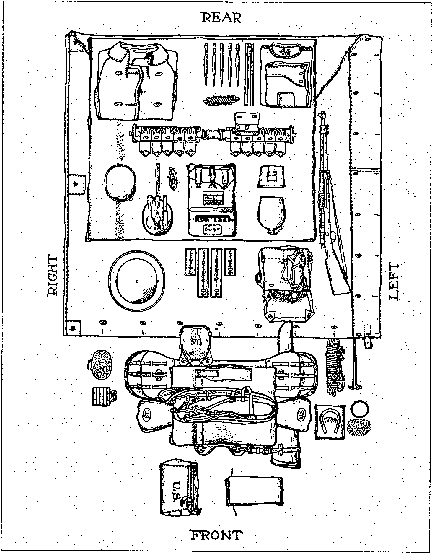
Equipment display for cavalryman, 1918. (From War
Department Field Manual)
 --
--
McClellan saddle, full pack, near side. --------------McClellan saddle,
full pack, off side.
(From War Department Field Manual)------(From War Department Field Manual)
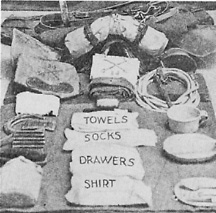
In World War I a new series of equipment was issued and known collectively
as the M1917/18 models. The M1918 dismounted cartridge belt had attached
a 20-round magazine carrier, a M1917 trench knife with a steel, ribbed,
knuckle guard for hand-to-hand combat, the M1910 canteen cover and first
aid pouch. The Mk. I trench knife had a brass knuckle guard. The M1918 pistol
belt could carry the M1917 revolver cartridge pouch, and M1917 revolver
holster made for either the Smith and Wesson or Colt M1917 revolver. A M1918
pistol magazine pocket could also be attached. Other specialized equipment
was the M1918 shotshell pouch for 12-gauge shells for the trench guns, the
M1910 wire cutter and carrier, and BAR magazine and rifle cartridge pockets,
as well as the BAR bandoleer, the ammunition carrier for the 3-inch trench
mortar, bolo with scabbard, bugle, discharger for rifle grenade, dispatch
case, record case, field glasses, clinometer for 3-inch trench mortar, clinometer
for machine gun, compass case, gas mask, angle-of-site instrument, and combination
flag kit.
Equipment arranged for inspection. (From War Department Field Manual)
-----------

Shelter tent and equipment arranged for inspection.
(From War Department Field Manual)

Individual equipment of cavalryman, including the
M1903 Springfield rifle and the Patton saber.
(From War Department Field Manual)
New models of personal equipment appeared over the next two decades, like the M1923 magazine pocket, the M1923 mounted and dismounted belts, the M1928 haversack, with a short pack roll, the M1938 12-pocket dismounted cartridge belt, the M1938 wire cutter and carrier, the M1924 first aid pouch, the magazine pocket for the M1928A1 Thompson submachine gun magazines, the M1936 musette bag, the M1938 dispatch bag also called a map case, the M1936 field bag, the M1936 suspenders, the M1936 pistol belt, the M1 holster ' and the M17 binoculars case. The M1938 cartridge belt was adopted to carry ammunition for the new M1 rifle clips but was discontinued in the early 1940s and the M1923 stayed in use.

The McClellan saddle mounted on wooden training horses
for cavalry recruits in 1918. (U.S. Army photo)
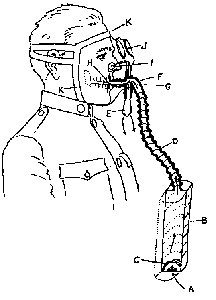 The M1904 McClellan saddle differed chiefly from the M1885 McClellan
in color (1902 regulations changed all leather from black to russet), in
the new quarter straps which buckled to straps affixed to the saddle tree,
and in the straight sides of the tree. Although slight changes were made
in 1928, this saddle was the basic model until the horse Cavalry was discontinued.
The M1904 McClellan saddle differed chiefly from the M1885 McClellan
in color (1902 regulations changed all leather from black to russet), in
the new quarter straps which buckled to straps affixed to the saddle tree,
and in the straight sides of the tree. Although slight changes were made
in 1928, this saddle was the basic model until the horse Cavalry was discontinued.
The box respirator. (From 1918 War College pamphlet)
A development of the 1912 Cavalry Equipment Board, M1916 officer's training saddle was designed solely for training at the Cavalry School. However, it was often purchased by officers and used until the M1936 Phillips saddle was prescribed.
An outgrowth of a cavalry equipment board convened in 1912, the M1917 officer's field saddle was used by all mounted officers in the field until 1936. It was in that year that the Phillips cross-country model was introduced for officers.
The R. F. K. Gas Mask was a box respirator modified from the British mask by Ralph R. Richardson, E. L. Flory, and Waldemar Kops of the Chemical Warfare Service. It was the first American gas mask. American troops wore French and British masks earlier in World War L It consisted of a canister, a fabric face piece with nose clip, mouth piece, and hosetube, and a carrier for the two units. It provided adequate protection against the agents used on the Western Front, but was uncomfortable if worn for long periods.
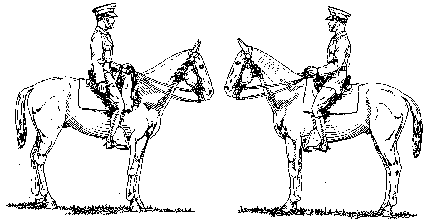
The mounted trooper, near side. --------------------The mounted trooper, off side.
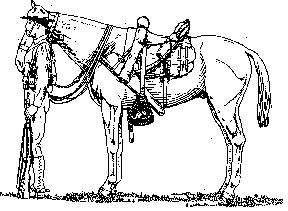
Trooper standing to horse, basic saddle pack, near
side.
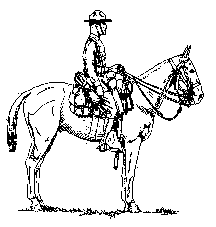 -------
-------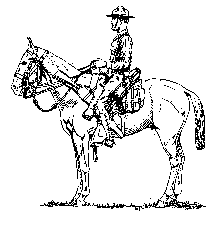
Trooper mounted, basic saddle pack, near side.--------------Trooper mounted, basic saddle pack, off side.
(From War Department Field Manual)